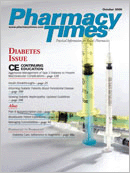Publication
Article
Pharmacy Times
generic times: product profiles
Author(s):
Estradiol TransdermalSystems
For most women, menopause symptomsspontaneously cease within 5years, yet many still experience hotflashes, sweating, vaginal dryness, andinsomnia well past the onset ofmenopause. Topical administration ofestrogens provides a convenient meansof replacing one aspect of this steroiddeficiency. Estradiol is available in atransdermal form requiring only once-weeklyadministration.
Pharmacology
Hormone replacement during menopauseis indicated for the relief of severevasomotor symptoms (hot flashes andnight sweats); if severe symptoms of vulvaror vaginal atrophy are involved, long-termapplication of topical patches maybe effective, but directly applied vaginalpreparations may be preferred to avoidgeneral systemic absorption and possiblyreduce side effects.
The use of transdermal estradiol is postulatedto reduce the risk for thromboembolitisassociated with estrogens by avoidingthe hepatic "first-pass effect." Controlledtrials have not been performed toconfirm this presumption, however.
Dosing and Administration
Once the protective strip on thepatch has been removed, the transdermalsystem is to be applied to a cleanand dry area of the intact skin on thetrunk of the body, preferably to theabdominal wall or buttocks. The patchshould be held in place for about 10seconds to ensure proper adhesion tothe skin. Application to the breasts orwaistline should be avoided. To minimizeirritation to the skin, applicationsites should be rotated.
This particular transdermal system ofestradiol requires application once weekly.If a patch is not replaced on the designatedday, it should be replaced as soonas possible to maintain the establishedschedule. Used patches should be folded,adhesive side in, and disposed of inan area away from children or pets.
The usual initial dose is one 0.025-mg/d patch applied once weekly. Thestrongest available dose is the 0.1-mg/d patch.
Side Effect and Interaction Profile
Because other non-estrogen-basedtherapy is available to treat osteoporosis,the use of supplemental estradiolonly for the treatment of osteoporosisshould be considered only in the contextof risks-benefits for the patient.The use of topical estradiol is accompaniedby the same contraindicationsassociated with estrogen use: a historyor suspicion of breast cancer or neoplasm,unrelated endometrial hyperplasia,presence or history of thromboembolismor thromboembolic disease(ie, angina or heart attack),untreated hypertension, or active liverdisease. Tobacco smoking, obesity, diabetes,and dyslipidemia also increasethe likelihood of estrogen-relatedthromboembolic conditions.
The most common side effect reportedfrom the use of these transdermalpatches has been erythema and irritationat the application site, which occurs innearly a third of women. Mastalgia, abdominalpain with cramps, nausea, andweight gain have also been reported.
Concurrent use of the antituberculindrug rifampin and the herb St.John's wort may diminish the effect ofestrogen supplements. The sameinteraction is possible with the coincidentuse of the antiseizure drugs phenobarbitaland phenytoin.
Clinical Outlook
Although naturaltherapies such asblack cohosh andisoflavones are becomingincreasinglypopular, traditional estrogensupplements such as estradiolmay also help alleviate many of thesymptoms associated with menopause,along with diet, calcium supplements,and weight-bearing exercises.
Estradiol is available in transdermalpatch strengths of 0.025 mg/d, 0.0375mg/d, 0.05 mg/d, 0.06 mg/d, 0.075 mg/d,and 0.1 mg/d from Mylan Laboratories Inc.
Sertraline Hydrochloride
Although the selective serotonin reuptakeinhibitor (SSRI) sertraline hydrochloride(HCl) is used in the treatment ofmajor depressive disorders, it is alsobeing used for refractory obsessive-compulsive disorders and some anxietyrelatedillnesses. Studies indicate thatsertraline HCl is more potent than fluvoxamine,fluoxetine, or clomipramine withits effect on serotonin levels. Its Nmethylatedmetabolite retains selectivityin serotonin reuptake inhibition.
Dosing
For the treatment of adult majordepression, the daily dose is 50 mg to100 mg, with possible weekly increasesto a maximum of 200 mg. Sustained dosingover several months is often requiredto achieve desired effects. Panic disorder,posttraumatic stress disorder, andsocial phobia are treated with an initialdaily dose of 25 mg, again with weeklyincreases to a daily maximum of 200 mg.Obsessive-compulsive disorders requirehigher daily doses in the range of 200 mgto 400 mg. Doses at this level, however,carry an 80% rate of adverse reactions.Doses should be discontinued slowly toprevent withdrawal symptoms followingprolonged use.
When using the liquid concentrate, thesertraline HCl dose must be carefullymeasured with the provided calibrateddropper and immediately administered,diluted in 4 ounces of water, ginger ale,lemonade, or orange juice.
Adverse Effects
The sensitivity of the GI tract to serotonin,coupled with the physiologiceffects of an SSRI, can result in increasednausea, xerostomia, and diarrhea duringtreatment with sertraline HCl. Somepatients experience treatment-inducedsweating. In addition, recent reports suggestthat 50% or more of patients usingSSRI therapy will describe some form ofsexual dysfunction during treatment.
Paradoxically, the use of SSRIssuch as sertraline HCl is sometimesassociated with a worseningof depression symptoms, oreven the emergence of suicidalthoughts and behaviors. Whileunsupported by controlled trials,empiric observations suggest thattreating a major depressiveepisode with just an antidepressantmay unmask an underlyingbipolar disorder. A careful psychiatric historyand screening are always necessarybefore initiation of therapy. Children aredeemed especially at risk, based on apooled analysis of data from 24 shorttermstudies involving 9 antidepressants,including sertraline HCl. As a result, theFDA has directed all antidepressant manufacturersto include a black-box warningin their package inserts advising ofthis possibility and has recommendedthat patient medication guides be dispensedwith each fill of an antidepressantprescription.
The rarely occurring "serotonin syndrome" is possible when sertraline HCl iscombined with other drugs that mayincrease serotonin levels. These drugsinclude lithium, tricyclic antidepressants,trazodone, dextromethorphan, meperidine,monoamine oxidase inhibitors, buspirone,and tramadol.
Since sertraline HCl is extensivelymetabolized in the liver, doses should bereduced and cautiously employed in thepresence of hepatic impairment.
Outlook
Sertraline HCl, in its branded form, represented$3 million in annual sales in2005. The expense of the branded productresulted in obligatory "pill splitting" to shave pharmacy benefit costs;patients were obliged to take half-tabletsof 100-mg strengths to obtain their 50-mg dose. Although this practice is controversial,no apparent medical harm topatients has been determined. The availabilityof the less-expensive generic formof sertraline HCl should help to temperthis mandated routine.
Sertraline HCl is available as an oralsolution containing 20 mg/mL fromRoxane Laboratories Inc, and in tabletstrengths of 25 mg, 50 mg, and 100 mgfrom Teva Pharmaceuticals USA and fromPfizer Inc's generic unit, Greenstone Ltd.
Mr. Middleton is an instructor of pharmacologyat Kellogg CommunityCollege in Battle Creek, Mich.







